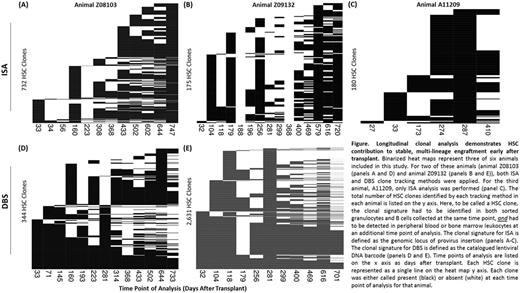Abstract
Summary:
Several models of hematopoietic reconstitution after transplant have been proposed with multiple methods of tracking individual clones in both animal models and patients. Lentivirus-mediated gene therapy is the most widely applied strategy for marking individual cells, tracked by either provirus integration site analysis (ISA) or by proviral DNA barcode sequencing (DBS). Two previous studies have applied one of each of these methods to track hematopoiesis in a nonhuman primate model of myeloablative autologous transplantation. The report using ISA described long-term, multi-lineage hematopoietic clones emerging at 1 year after transplantation [Kim S. et al., Cell Stem Cell, 2014]. The report using DBS described only early engraftment up to 9 months after transplant, precluding long term analysis [Wu C. et al., Cell Stem Cell, 2014]. We applied a combination of ISA and DBS methods to follow longitudinal hematopoiesis in a total of six nonhuman primates following autologous transplant in the myeloablative setting, tracking >120,000 individual clones for up to 10 years. We measured hematopoietic lineage reconstitution, as well as spatial and temporal contributions of individual clones within the bone marrow niche and peripheral blood. Here we applied a stringent definition of the hematopoietic stem cell (HSC) phenotype in vivo (i.e. shared clonal identity between short-lived granulocytes and long-lived B cells with multiple time points of detection), to assess HSC contributions after engraftment. Strikingly, we demonstrate sustained contribution of HSC clones occurs as early as 1 month after transplant and that minor clonal waves continuously emerge when the measureable clonal pool is small in size, but not when the initial engrafting clonal pool is robust. Nearly one half of all HSC clones identified over the length of follow-up were detectable in the periphery within a few months after transplant by both ISA and DBS methods. However, we also identify technical differences between these clone tracking methods that can obscure biological interpretation. This study demonstrates an early and robust phase of multi-lineage hematopoietic reconstitution after myeloablative transplantation in the nonhuman primate, suggesting a single subpopulation of CD34+ cells which maintains clonal stability over the lifetime of the recipient in the autologous setting.
Adair:Rocket Pharmaceuticals: Consultancy, Equity Ownership. Porteus:CRISPR Therapeutics: Consultancy, Equity Ownership. Kiem:Rocket Pharmaceuticals: Consultancy, Equity Ownership, Research Funding.
Author notes
Asterisk with author names denotes non-ASH members.


This feature is available to Subscribers Only
Sign In or Create an Account Close Modal